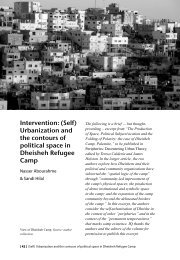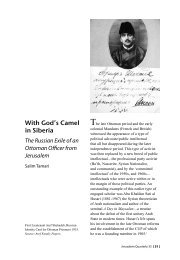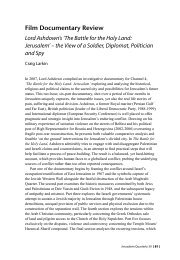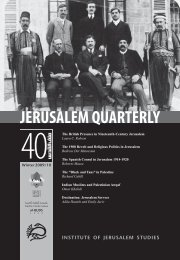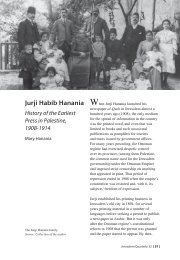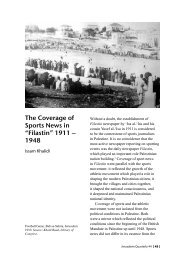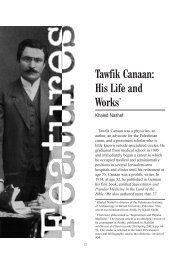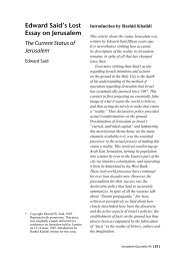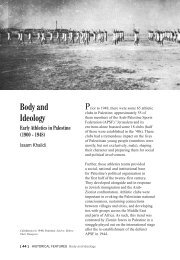PLUNDERING PALESTINE - Jerusalem Quarterly
PLUNDERING PALESTINE - Jerusalem Quarterly
PLUNDERING PALESTINE - Jerusalem Quarterly
Create successful ePaper yourself
Turn your PDF publications into a flip-book with our unique Google optimized e-Paper software.
ministry appeared willing to accept the proposal, but then broke its promise, claiming<br />
that due to the presence of antiquities and insufficient time to excavate them, the Wall<br />
would have to remain east of Quffin’s cultivated fields.<br />
There are over 100 major archaeological sites in the area between Zabuba and<br />
Shweika, says the Palestinian Antiquities Department. The sites in this area date from<br />
the Bronze Age to the Ottoman period, and include ancient dwellings and population<br />
centres, as well as individual items including caves, tombs, rural castles and<br />
agricultural equipment such as grape presses and farm roads.<br />
Saffa<br />
Located 17 km west of Ramallah, the village of Saffa has lost some 5,000 dunams<br />
of land due to the path of the Wall. This area includes at least six identified<br />
archaeological sites that will be either destroyed or separated from the village as a<br />
result of the Wall. These sites are located to the west of the village and will surely be<br />
annexed to Israel as soon as the wall is completed. These sites are:<br />
Khirbet al-Amma: a Byzantine settlement with a defensive wall, stone cut burial<br />
grounds, wine and olive presses, and mosaic pavements. The construction of the<br />
Wall has destroyed the eastern and southern parts of the site.<br />
Khirbet Krikur: a Hellenistic Roman site inhabited up until the early Ottoman<br />
period. It is located west of the village and measures around 3,000 sq. meters in<br />
area. The site includes several major archaeological features such as walls, wells,<br />
and olive and wine presses. The site was hastily excavated early in 2005 to prepare<br />
for the wall, which will be constructed right over it.<br />
Khirbet Kresna: a site with Roman, Byzantine and early Islamic remains located<br />
to the west of the village and measuring 1,500 sq. meters in area. The site has a<br />
defensive wall made of massive stones measuring 3.5m in height. The site also<br />
includes a number of caves, wine presses and water wells. Due to the course of the<br />
wall, the site will be confiscated and likely used to enlarge the neighbouring Israeli<br />
settlement of Labid.<br />
Khirbet al-Dalia: a site with Roman, Byzantine and early Islamic remains, located<br />
to the west of the village and measuring 7,000 sq. meters in area.<br />
Khirbet Horia: a site with Roman, Byzantine, Islamic and early Ottoman remains,<br />
located to the west of the village and measuring 7,000 sq. meters in area. The site<br />
includes coloured mosaic pavements of churches and remains of a mosque. The<br />
Israeli Department of Antiquities of the Israeli Civil Administration conducted a<br />
large excavation at the site earlier in 2005 in preparation for the Wall.<br />
[ 46 ] FEATURES VieLooting and ‘Salvaging’



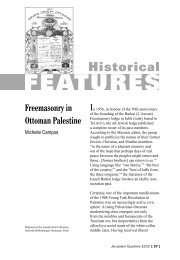
![In Search of Jerusalem Airport [pdf] - Jerusalem Quarterly](https://img.yumpu.com/49007736/1/180x260/in-search-of-jerusalem-airport-pdf-jerusalem-quarterly.jpg?quality=85)
